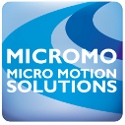 |
| July 28, 2015 | Volume 11 Issue 28 |
Motion Control News & Products
Designfax weekly eMagazine
Archives
Partners
Manufacturing Center
Product Spotlight
Modern Applications News
Metalworking Ideas For
Today's Job Shops
Tooling and Production
Strategies for large
metalworking plants
Robots think and act on the fly at moving assembly line speeds
 Inbolt and FANUC are launching a manufacturing breakthrough enabling FANUC robots to tackle one of the most complex automation challenges: performing production tasks on continuously moving parts at line speeds. With Inbolt's AI-powered 3D vision, manufacturers can now automate screw insertion, bolt rundown, glue application, and other high-precision tasks on parts moving down the line without costly infrastructure investments or cycle time compromises.
Inbolt and FANUC are launching a manufacturing breakthrough enabling FANUC robots to tackle one of the most complex automation challenges: performing production tasks on continuously moving parts at line speeds. With Inbolt's AI-powered 3D vision, manufacturers can now automate screw insertion, bolt rundown, glue application, and other high-precision tasks on parts moving down the line without costly infrastructure investments or cycle time compromises.
Learn more.
Best high-speed rotary bearing in THK history
 THK has developed its best-performing, high-speed rotary bearing ever: the High-Speed, Double-Row Angular Contact Ring BWH. This rotary bearing has balls aligned inside a cage between the inner and outer rings and is part of the THK Rotary Series, along with the cross-roller ring. The main features of this product are its ability to receive loads in all directions as well as its high rigidity and rotational accuracy, which are equal to that of cross-roller rings. By adopting a new structure to change the rolling elements from rollers to balls, this product achieves the greatest high-speed performance ever offered by THK.
THK has developed its best-performing, high-speed rotary bearing ever: the High-Speed, Double-Row Angular Contact Ring BWH. This rotary bearing has balls aligned inside a cage between the inner and outer rings and is part of the THK Rotary Series, along with the cross-roller ring. The main features of this product are its ability to receive loads in all directions as well as its high rigidity and rotational accuracy, which are equal to that of cross-roller rings. By adopting a new structure to change the rolling elements from rollers to balls, this product achieves the greatest high-speed performance ever offered by THK.
Learn more.
Elevating tables: Precise vertical positioning in tight spaces
 As semicon-ductors and optical components become smaller and more sophisticated, the TZ Series of precision elevating tables from IKO International provides exceptional vertical positioning accuracy in a compact size. This unit features a unique wedge mechanism guided in the vertical direction by a pair of IKO C-Lube Super MX linear motion rolling guides arranged in parallel to achieve highly precise positioning with exceptional rigidity. An optional linear encoder provides full closed loop control to achieve positioning accuracy as high as 0.005 mm, with repeatability of +/-0.001 mm.
As semicon-ductors and optical components become smaller and more sophisticated, the TZ Series of precision elevating tables from IKO International provides exceptional vertical positioning accuracy in a compact size. This unit features a unique wedge mechanism guided in the vertical direction by a pair of IKO C-Lube Super MX linear motion rolling guides arranged in parallel to achieve highly precise positioning with exceptional rigidity. An optional linear encoder provides full closed loop control to achieve positioning accuracy as high as 0.005 mm, with repeatability of +/-0.001 mm.
Learn more and get all the specs.
This cobot is all about safety around people
 The COBOTTA PRO from DENSO Robotics is a lightweight, high-speed collaborative robot designed for communication between workers and robots while maximizing productivity. It delivers a blend of productivity and safety for both simple tasks and multi-step processes like assembly and inspection work. The 6-axis unit operates at speeds up to 2,500 mm per sec when no workers are near and slows or stops when people approach. Two models available: PRO 900 (max payload 6 kg) and PRO 1300 (max payload 12 kg). Many more functions and features.
The COBOTTA PRO from DENSO Robotics is a lightweight, high-speed collaborative robot designed for communication between workers and robots while maximizing productivity. It delivers a blend of productivity and safety for both simple tasks and multi-step processes like assembly and inspection work. The 6-axis unit operates at speeds up to 2,500 mm per sec when no workers are near and slows or stops when people approach. Two models available: PRO 900 (max payload 6 kg) and PRO 1300 (max payload 12 kg). Many more functions and features.
Learn more.
Powerful, pull-type clapper solenoids handle myriad jobs
 New powerful, low-profile, pull-type clapper solenoids are available from Magnetic Sensor Systems (MSS). Applications include valve control, locks, starters, ventilators, clamping, sorting, appliances, tools, HVAC, brakes, clutches, switches, mixing, fire suppression systems, door controls, detent latches, and more. The S-16-264 Series of 17 Pull-Type Clapper Solenoids have ampere turns (windings) adjusted to meet the specific force and duty cycle requirements of your application. They provide up to 130 lb (578 N) of force.
New powerful, low-profile, pull-type clapper solenoids are available from Magnetic Sensor Systems (MSS). Applications include valve control, locks, starters, ventilators, clamping, sorting, appliances, tools, HVAC, brakes, clutches, switches, mixing, fire suppression systems, door controls, detent latches, and more. The S-16-264 Series of 17 Pull-Type Clapper Solenoids have ampere turns (windings) adjusted to meet the specific force and duty cycle requirements of your application. They provide up to 130 lb (578 N) of force.
Get all the specs for these solenoids and other options.
Tech Tip: Belt, screw, or chain-driven actuator?
 Bishop-Wisecarver provides a quick, very useful guide to help you evaluate the right drive strategy for your system: belt, screw, or chain-driven actuator. Each drive type has unique advantages and limitations, so evaluating all your options will help you find the most suitable actuator setup for your specific application needs.
Bishop-Wisecarver provides a quick, very useful guide to help you evaluate the right drive strategy for your system: belt, screw, or chain-driven actuator. Each drive type has unique advantages and limitations, so evaluating all your options will help you find the most suitable actuator setup for your specific application needs.
Read the Bishop-Wisecarver blog.
Ultra-precise linear stage -- down to 0.005 microns
 PI, a global leader in precision motion control and nanoposi-tioning, now offers fast delivery of the L-511 linear micropositioning stage, which is designed for applications requiring minimum incremental motion down to 20 nm, drive forces up to 22 lb, and multi-axis configuration options. The L-511 can be combined to form XY or XYZ motion systems and integrated with rotary stages. A variety of drive and encoder options (stepper and servo motors, rotary, and linear encoders) enable ultra-fine sensitivity. Applications include: metrology, laser processing, semiconductors, biotech, optical alignment, and advanced automation.
PI, a global leader in precision motion control and nanoposi-tioning, now offers fast delivery of the L-511 linear micropositioning stage, which is designed for applications requiring minimum incremental motion down to 20 nm, drive forces up to 22 lb, and multi-axis configuration options. The L-511 can be combined to form XY or XYZ motion systems and integrated with rotary stages. A variety of drive and encoder options (stepper and servo motors, rotary, and linear encoders) enable ultra-fine sensitivity. Applications include: metrology, laser processing, semiconductors, biotech, optical alignment, and advanced automation.
Learn more and get all the specs.
Choosing the right stepper motor: PM or hybrid?
 According to the experts at Lin Engineering, there are two primary types of stepper motors to consider: permanent magnet (PM) and hybrid. But which is right for your application? Both types have their advantages and disadvantages, and the choice ultimately depends on your specific requirements.
According to the experts at Lin Engineering, there are two primary types of stepper motors to consider: permanent magnet (PM) and hybrid. But which is right for your application? Both types have their advantages and disadvantages, and the choice ultimately depends on your specific requirements.
Read this informative Lin Engineering article.
New PTFE-free linear guide for precise positioning
 The new drylin WWP linear guide from igus features a PTFE-free locking carriage. Engineered from lubrication-free, high-performance polymers and aluminum, the guide offers a lightweight, hygienic, and low-maintenance alternative to complex mechanical and electronic adjustment systems. It is significantly more compact and lightweight than conventional recirculating ball-bearing systems. Applications include interior components in vehicles, aircraft, and furniture.
The new drylin WWP linear guide from igus features a PTFE-free locking carriage. Engineered from lubrication-free, high-performance polymers and aluminum, the guide offers a lightweight, hygienic, and low-maintenance alternative to complex mechanical and electronic adjustment systems. It is significantly more compact and lightweight than conventional recirculating ball-bearing systems. Applications include interior components in vehicles, aircraft, and furniture.
Learn more and get all the specs.
Heavy-duty gear units for mixing and agitating systems
 MAXXDRIVE industrial gear units from NORD DRIVE-SYSTEMS are an established drive solution for heavy-duty applications. In addition to conveying, lifting, and driving, they also play an important role in mixing and agitating systems. MAXXDRIVE units feature a compact, one-piece UNICASE housing that delivers long service life, easy maintenance, and quiet operation. Their robust design handles high axial and radial loads, achieves output torques up to 2,495,900 lb-in., and powers up to 8,075 hp.
MAXXDRIVE industrial gear units from NORD DRIVE-SYSTEMS are an established drive solution for heavy-duty applications. In addition to conveying, lifting, and driving, they also play an important role in mixing and agitating systems. MAXXDRIVE units feature a compact, one-piece UNICASE housing that delivers long service life, easy maintenance, and quiet operation. Their robust design handles high axial and radial loads, achieves output torques up to 2,495,900 lb-in., and powers up to 8,075 hp.
Learn more.
What are non-captive linear actuators?
 According to PBC Linear, their new non-captive linear actuators are different from the more common external versions of lead screw-driven linear actuators because they allow the lead screw to completely pass through the motor. This fundamental difference offers advantages for designs that have limited space available or for engineers looking to shrink the overall size of their design package.
According to PBC Linear, their new non-captive linear actuators are different from the more common external versions of lead screw-driven linear actuators because they allow the lead screw to completely pass through the motor. This fundamental difference offers advantages for designs that have limited space available or for engineers looking to shrink the overall size of their design package.
Read the full PBC Linear blog.
Güdel introduces Swiss-quality tracks for cobots
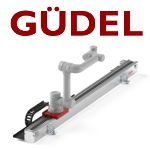 Güdel Inc. is highlighting new technologies at Automate 2025 booth #2418 that demonstrate its unmatched ability to solve automation engineering challenges. One is the Cobomover, a 7th-axis linear track purpose-built for collaborative and lightweight robots. Designed and manufactured in Switzerland, this unit extends the working range of robots up to 5 m, allowing them to operate multiple workstations and perform a variety of tasks without manual repositioning. Compatible with over 60 cobots and small traditional robots.
Güdel Inc. is highlighting new technologies at Automate 2025 booth #2418 that demonstrate its unmatched ability to solve automation engineering challenges. One is the Cobomover, a 7th-axis linear track purpose-built for collaborative and lightweight robots. Designed and manufactured in Switzerland, this unit extends the working range of robots up to 5 m, allowing them to operate multiple workstations and perform a variety of tasks without manual repositioning. Compatible with over 60 cobots and small traditional robots.
Learn more and get all the specs.
New open-center XYZ stage
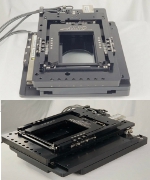 ThruSight-Focus is a high-performance, compact motion platform specifically engineered for applications requiring dual-side access to the sample or workpiece. It pairs ALIO's monolithic open-center XY stage -- known for its nanometer-level precision, crossed roller bearings, and direct linear drives -- with a novel Z-wedge mechanism that converts horizontal drive force into vertical motion via direct drive. This innovative architecture eliminates backlash, enhances servo responsiveness, and delivers fast, stable Z-axis movements -- all within a low-profile footprint.
ThruSight-Focus is a high-performance, compact motion platform specifically engineered for applications requiring dual-side access to the sample or workpiece. It pairs ALIO's monolithic open-center XY stage -- known for its nanometer-level precision, crossed roller bearings, and direct linear drives -- with a novel Z-wedge mechanism that converts horizontal drive force into vertical motion via direct drive. This innovative architecture eliminates backlash, enhances servo responsiveness, and delivers fast, stable Z-axis movements -- all within a low-profile footprint.
Learn more.
Eaton unveils differential engineered for EVs
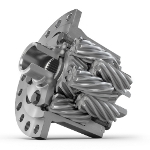 Intelligent power management company Eaton launched a new differential engineered specifically for electric vehicles at Auto Shanghai 2025 in China. The innovative design addresses the unique challenges presented by EV propulsion systems, including shared low-viscosity oil environments, increased sensitivity to noise, and the demands of high and instant torque delivery.
Intelligent power management company Eaton launched a new differential engineered specifically for electric vehicles at Auto Shanghai 2025 in China. The innovative design addresses the unique challenges presented by EV propulsion systems, including shared low-viscosity oil environments, increased sensitivity to noise, and the demands of high and instant torque delivery.
Read the full article.
Top Product: Integrated servo system is 20% smaller than standalone unit
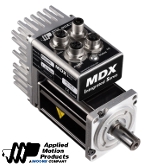 Applied Motion Products has introduced the MDX+ series, a family of low-voltage servo systems that integrate a servo drive, motor, and encoder into one package. This all-in-one drive is an ideal solution for manufacturers in logistics, AGV, medical, semiconductor, the solar industries, and many others.
Applied Motion Products has introduced the MDX+ series, a family of low-voltage servo systems that integrate a servo drive, motor, and encoder into one package. This all-in-one drive is an ideal solution for manufacturers in logistics, AGV, medical, semiconductor, the solar industries, and many others.
Read the full article.
Nanosatellites being tested to communicate with U.S. Soldiers
By David Vergun, U.S. Army
Tiny Army satellites may someday provide Soldiers with voice, data, and even visual communications in remote areas, which lack such communications.
Already some of that technology has been successfully tested, said Dr. Travis Taylor.
Taylor is the senior scientist for Space Division, U.S. Army Space and Missile Defense Command - Tech Center, or SMDC, at Redstone Arsenal, AL. He spoke during Lab Day at the Pentagon, May 14, 2015.
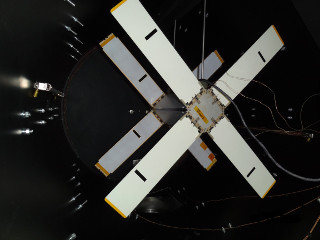
The main goal of the SMDC-ONE nanosatellite tests is to demonstrate voice and data communications through a low-Earth orbit satellite using military standard radios. During its first test 185 miles up, ground stations in Huntsville, AL, and Colorado Springs, CO, sent messages back and forth via the satellite, demonstrating beyond-line-of-sight and over-the-horizon communications between stations over 1,000 miles apart. [Photo Credit: U.S. Army]
Voice, data
In many remote areas where Soldiers operate today, Army radio over-the-horizon communication from the field to higher headquarters like the brigade is nonexistent, Taylor said.
To address this gap in coverage, Army scientists and researchers built the SMDC-ONE nanosatellite, he said, the ONE standing for Orbital Nanosatellite Effect. "It's basically a cellphone tower in space, except it's not for cellphones, it's for Army radios," Taylor said.
The 13-in.-long, 10-lb SMDC-ONE satellite is currently a technology demonstration, he said, adding that one has been successfully tested. It's up in space right now communicating. Three more are scheduled to go up this year, and an undetermined number will go up next year as well.
"Hopefully, we're at a point in the process where the technology is proven and they're wanted, perhaps three to five years" from now, Taylor said.
"If we put five to 12 of these small satellites in orbit, it will cover most areas Soldiers are operating, providing them real-time, all-the-time" communications, he said. Once we've proven it can be done, it will be time to start to deploy a "real constellation" of them that the warfighters can use.
SMDC-ONE is the first Army-developed satellite launched in more than 50 years.
Imagery
What if a Soldier not only wants to communicate, but wants to see if there's a threat or something of interest over the next hill or the other side of a city? Taylor asked rhetorically.
The answer is an imaging satellite, which is several times larger than SMDC-ONE, but still considered nano, he said. This satellite, which is still unnamed, will be given a space test-flight in February 2016, launched from the International Space Station.
The imaging satellite will produce a ground resolution of 2 to 3 meters, he said. That's high enough resolution to inform a Soldier if he's looking at a tank or a truck. Or, if there's smoke in an urban area, the Soldier will be able to tell which building it's coming from. "This is capability the Army doesn't have right now."
Once the technology is successfully demonstrated, the next step will be to establish the process for how it works and provide training to the Soldiers.
"The first step is proving we can collect [the data] and the next step is disseminating it," he explained. For example, a squad leader might need to ask brigade for an image over the next hill. Someone at brigade would need to prioritize that request, because the satellite can only process one image at a time, usually in about a minute.
Then, the data from that image or even the image itself would need to be pushed out to the Soldier on the ground, he said. The details are still fuzzy about how all of that would work, so the focus for now is getting through the demonstration phase.
How it's put in space
The technology is already proven, Taylor said. The biggest challenge is getting the satellites hitched on a ride into space, where they'd be in low-Earth orbit. Most are launched now by piggybacking them as part of a larger payload of a spaceship.
One problem is, you can't put rocket motors on these to change their orbits, because it's considered too dangerous for the mothership and the other payloads, he said, meaning it could inadvertently explode. So, when the mothership drops off its payloads, the Army satellite might not be in an optimal position in space since the mothership can't zigzag around dropping off each payload in different places where their optimal orbits are located.
"So we developed a clever way around that," Taylor said, holding up a plastic container about the size and shape of a fancy pill bottle.
"This is an actual rocket motor, made from a plastic printer," he said. "Inside is liquid nitric oxide and a sparker -- just like a barbeque lighter inside -- so the nitric oxide combusts with the plastic" when the sparker is fired. "That's your rocket fuel. Then you have a very good rocket motor."
Once the rocket motor puts the satellite in correct orbit, the satellite still needs to orient its solar panel array so it's continuously tracking the sun and collecting energy, he said.
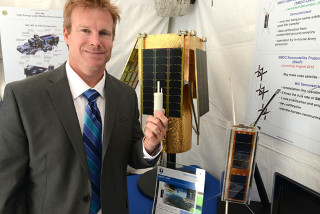
Dr. Travis Taylor, senior scientist for Space Division, U.S. Army Space and Missile Defense Command - Tech Center is shown holding a plastic liquid nitric oxide container, which propels the satellite into low-Earth orbit after it leaves the mothership. Behind him is the imagery satellite, and to the right is the smaller data and voice satellite. [Photo Credit: David Vergun]
To do that, the satellite contains three wheels spinning in the x, y, and z axis called momentum wheels, he explained. They act like gyros and can be programmed by speeding or slowing each one to adjust the orbit or orientation of the spacecraft. There are also magnetic torque rods in the satellite that interact with the magnetic field of the Earth to help align it.
Once in space, the satellites are not completely immune from damage, Taylor said. Besides space debris, there's solar flares and coronal mass ejections that could penetrate the satellite's shielding. "But we do everything we can to harden and ruggedize them."
These satellites are very inexpensive, he said, adding the biggest cost is the launch.
Taylor concluded: "It's exciting to work with spacecraft that can actually help warfighters in the field of the future. We've had many would-be users tell us that if they had this, they'd use it tomorrow, so I think the odds are good this will be something we see in the future."
Published July 2015
Rate this article
View our terms of use and privacy policy
